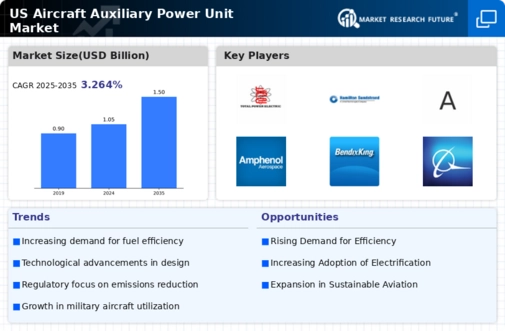The US Aircraft Auxiliary Power Unit Market is characterized by a robust competitive landscape that fosters innovation and growth in the aerospace sector. With the increasing demand for efficient and environmentally friendly power solutions for aircraft, various players are vying to establish a significant foothold in this market. Companies are engaged in strategic collaborations, technological advancements, and expanding their product portfolios to meet the unique needs of both commercial and military aircraft. This competitive environment is driven by the need to enhance aircraft performance, reduce operational costs, and comply with stringent regulatory standards.
As a result, the market witnesses ongoing developments focused on improving the efficiency and reliability of auxiliary power units, thereby providing companies with ample opportunities to differentiate themselves and gain market share.Microturbo, a notable player in the US Aircraft Auxiliary Power Unit Market, has established a strong market presence due to its advanced technological capabilities and an expansive product range. The company's commitment to developing state-of-the-art auxiliary power units has positioned it as a reliable provider in the industry. Microturbo's strengths lie in its innovative designs, which focus on optimizing performance while minimizing weight and energy consumption.
The company emphasizes high reliability and operational efficiency, catering to both commercial aviation and military applications. With a reputation for superior engineering and a deep understanding of the market's demands, Microturbo has effectively captured a significant share of the US market, enabling it to remain competitive against emerging industry trends.Honeywell International plays a crucial role in the US Aircraft Auxiliary Power Unit Market through its diverse offerings and extensive market reach.
The company provides high-quality auxiliary power units that are integral to the operations of modern aircraft, ensuring power supply for essential systems during ground operations and while in the air. Honeywell's key products in this space incorporate advanced technologies that enhance performance, safety, and fuel efficiency. The company's established presence in both commercial and military sectors demonstrates its ability to cater to a wide range of customers. Additionally, Honeywell is known for its strategic mergers and acquisitions, allowing it to consolidate resources, expand its technological capabilities, and drive innovation in auxiliary power systems.
This proactive approach ensures that Honeywell remains a leading force in the US market, consistently adapting to evolving customer needs and regulatory requirements while reinforcing its strength as a key player in the aerospace industry.





















Leave a Comment